Articles
- Page Path
- HOME > Korean J Community Nutr > Volume 17(4); 2012 > Article
-
Original Article
- Development and Evaluation of a Nutrition Education Website for the Prevention and Management of Childhood Obesity
- Miyong Yon, Chan Park, Kwan-Hee Yoo, Taisun Hyun
-
Korean Journal of Community Nutrition 2012;17(4):390-406.
DOI: https://doi.org/10.5720/kjcn.2012.17.4.390
Published online: August 31, 2012
Nutrition Policy Team, Korea Health Industry Development Institute, Chungbuk, Korea.
1Department of Digital Informatics & Convergence, Chungbuk National University, Cheongju, Korea.
2Department of Food and Nutrition, Chungbuk National University, Cheongju, Korea.
- Corresponding author: Taisun Hyun, Department of Food and Nutrition, Chungbuk National University, Cheongju 361-763, Korea. Tel: (043) 261-2790, Fax: (043) 267-2742, taisun@chungbuk.ac.kr
Copyright © 2012 The Korean Society of Community Nutrition
- 151 Views
- 0 Download
- 4 Crossref
Abstract
- Childhood obesity has rapidly increased worldwide and is one of the most serious health problems in this age group. In order to prevent and manage childhood obesity, we developed a nutrition education website. The website consisted of three parts. The first part was made for self-assessment with regard to obesity index, dietary habits, food frequency, dietary attitude, nutrition knowledge, nutrient intake, energy expenditure, and the stage of behavioral change, and tailored messages and advice according to the assessment results. A total of 612 real-size food photos as well as a nutrient database of 3,346 foods and 541 dishes were created to help children estimate nutrient intakes accurately. In addition, an energy expenditure database of 156 activities for children was established to calculate calorie consumption. The second part was made for setting long-term and short-term goals and keeping track of the changes in energy intake and expenditure in one's own page. The third part was made for education. Various types of nutrition information were provided; texts, pictures, calculators and games. The readability and design of the website were evaluated by 46 obese children. Usefulness, design and readability of the website were found to be desirable for children. This website is expected to be used by an obese child alone or with parents or nutrition teachers in order to control body weight through healthy dietary habits and physical activities. In addition, a non-obese child can also use this website for maintaining healthy dietary habits and preventing obesity.
-
This work was supported by the Korea Research Foundation Grant funded by Korea Government (MOEHRD, Basic Reseach Promotion Fund) (KRF-2005-204-C00102).
NOTES
- 1. Ahn HS, Ku BS, Lee SM. Systematic evaluation on the quantitative and qualitative aspects of Korean nutrition education websites. J Korean Diet Assoc. 2008; 14(3): 218-228.
- 2. Ainsworth BE, Haskell WL, Leon AS, Jacobs DR Jr, Montoye HJ, Sallis JF, Paffenbarger RS. Compendium of physical activities: classification of energy costs of human physical activities. Med Sci Sports Exerc. 1993; 25(1): 71-80.ArticlePubMed
- 3. Ainsworth BE, Haskell WL, Whitt MC, Irwin ML, Swatz AM, Strath SJ, O'Brien WL, Bassett DR Jr, Schmitz KH, Emplaincourt PO, Jacobs DR Jr, Leon AS. Compendium of physical activities: an update of activity codes and MET intensities. Med Sci Sports Exerc. 2000; 32(9 Suppl): S498-S504.ArticlePubMed
- 4. Bae HJ, Park HJ, Chea MJ, Yoon EY, Kim KW, Seo JS. Evaluation for food and nutrition information sites on the internet. J Korean Diet Assoc. 2006; 12(4): 404-410.
- 5. Brug J, Campbell M, van Assema P. The application and impact of computer-generated personalized nutrition education: a review of the literature. Patient Educ Couns. 1999; 36(2): 145-156.ArticlePubMed
- 6. Brug J, Oenema A, Kroeze W, Raat H. The internet and nutrition education: challenges and opportunities. Eur J Clin Nutr. 2005; 59(Suppl 1): S130-S137.ArticlePubMedPDF
- 7. Brug J, Steenhuis I, van Assema P, de Vries H. The impact of a computer-tailored nutrition intervention. Prev Med. 1996; 25(3): 236-242.ArticlePubMed
- 8. Caccialanza R, Nicholls D, Cena H, Maccarini L, Rezzani C, Antonioli L, Dieli S, Roggi C. Validation of the Dutch Eating Behaviour Questionnaire parent version (DEBQ-P) in the Italian population: a screening tool to detect differences in eating behaviour among obese, overweight and normal-weight preadolescents. Eur J Clin Nutr. 2004; 58(9): 1217-1222.ArticlePubMedPDF
- 9. Chen JL, Weiss S, Heyman MB, Vittinghoff E, Lustig R. Pilot study of an individually tailored educational program by mail to promote healthy weight in Chinese American children. J Spec Pediatr Nurs. 2008; 13(3): 212-222.ArticlePubMedPMC
- 10. Cotugna N, Vickery CE, Barrar C. The INK Project: Internet Nutrition for Kids. J Nutr Educ. 1999; 31(3): 179-180.Article
- 11. De Bourdeaudhuij I, Van Cauwenberghe E, Spittaels H, Oppert JM, Rostami C, Brug J, Van Lenthe F, Lobstein T, Maes L. School-based interventions promoting both physical activity and healthy eating in Europe: a systematic review within the HOPE project. Obes Rev. 2011; 12(3): 205-216.ArticlePubMed
- 12. de Graaf C, Van der Gaag M, Kafatos A, Lennernas M, Kearney JM. Stages of dietary change among nationally-representative samples of adults in the European Union. Eur J Clin Nutr. 1997; 51: Suppl 2. S47-S56.PubMed
- 13. Doshi A, Patrick K, Sallis JF, Calfas K. Evaluation of physical activity web sites for use of behavior change theories. Ann Behav Med. 2003; 25(2): 105-111.ArticlePubMed
- 14. Her ES, Lee KH. Utilization status of internet and dietary information of school children in Gyeongnam and Jeonbuk areas. Korean J Community Nutr. 2003a; 8(1): 15-25.
- 15. Her ES, Lee KH. Effect-evaluation of nutritional education program using internet for school children. Korean J Nutr. 2003b; 36(5): 500-507.
- 16. Hong YS. A survey on the elementary students internet using. Educ Dev. 2005; 21(1): 73-91.
- 17. Hyun TS, Kang NM. Evaluation of websites on nutrition information. Korean J Diet Cult. 2001; 16(1): 20-26.
- 18. Hyun T, Yon MY, Kim SH, Kim NH, An SM, Chi HJ, Sun MH, Oh CH, Wang SH, Hong MK. Development of a nutrition education website for children. Korean J Community Nutr. 2003; 8(3): 259-269.
- 19. Johnson F, Wardle J, Griffith J. The adolescent food habits checklist: reliability and validity of a measure of healthy eating behaviour in adolescents. Eur J Clin Nutr. 2002; 56(7): 644-649.ArticlePubMedPDF
- 20. Joo EJ, Kim IS, Kim YS, Seo EA. Determining the frequency of obesity and eating habits of older (4th, 5th, 6th grade) elementary school students in Iksan city by some obesity indices. Korean J Community Nutr. 2001; 6(1): 16-27.
- 21. Jung KA. The present state of nutrition education materials for elementary school students. J Korean Pract Arts Educ. 2008; 21(4): 107-137.
- 22. Kim EK. Eating behaviors and nutrition related problems in Korean children. Korean J Community Nutr. 2001; 6(5): 905-920.
- 23. Kim GM, Lee SY. The study on nutritional knowledge and eating behavior of elementary school senior students in Incheon area. J Korean Diet Assoc. 2000; 6(2): 97-107.
- 24. Kim KW, Kang HJ, Kim KA, Kim SH. Development of a website-based nutrition education program for female college students and young women. Korean J Community Nutr. 2001; 6(4): 657-667.
- 25. Kim SH, Hyun TS. Evaluation of a nutrition education website for children. Korean J Community Nutr. 2006; 11(2): 218-228.
- 26. Kipp DE, Radel JD, Hogue JA. The internet and the nutritional scientist. Am J Clin Nutr. 1996; 64(4): 659-662.ArticlePubMed
- 27. Korea Centers for Disease Control and Prevention, Korean Pediatric Society. Korean children and adolescents growth standard. 2007; cited 2012 March 15. Available from: http://www.cdc.go.kr.
- 28. Korea Internet & Security Agency. Summary Report on 2011 Internet Use Survey. 2011; cited 2012 August 5. Available from http://isis.kisa.or.kr/board/index.jsp?pageId=060200&bbsId=3&itemId=793&pageIndex=1.
- 29. Korean Nutrition Society. Recommended Dietary Allowances for Koreans. Nutrient Database. 2000; 7th revision.
- 30. Korean Nutrition Society. Dietary Reference Intakes for Koreans. 2005.
- 31. Ku BJ, Lee KA. A survey on dietary habit and nutritional knowledge for elementary school children's nutritional education. Korean J Diet Cult. 2000; 15(3): 201-213.
- 32. Lee SY, Kang HK, Yang IS, Kang MH. Analysis of contents of nutrition information on the internet. J Korean Diet Assoc. 2004; 10(2): 224-234.
- 33. Lopez-Azpiazu I, Martinez-Gonzalez MA, Leon-Mateos A, Kearney J, Gibney M, Martinez JA. Stages of dietary change and nutrition attitudes in the Spanish population. Public Health. 2000; 114(3): 183-189.ArticlePubMed
- 34. Macqueen CE, Brynes AE, Frost GS. Treating obesity: a follow-up study. Can the stages of change model be used as a postal screening tool? J Hum Nutr Diet. 2002; 15(1): 3-7.ArticlePubMed
- 35. Maes L, Cook TL, Ottovaere C, Matthijs C, Moreno LA, Kersting M, Papadaki A, Manios Y, Dietrich S, Hallstrm L, Haerens L, De Bourdeaudhuij I, Vereecken C. Pilot evaluation of the HELENA (Healthy Lifestyle in Europe by Nutrition in Adolescence) Food-O-Meter, a computer-tailored nutrition advice for adolescents: a study in six European cities. Public Health Nutr. 2011; 14(7): 1292-1302.PubMed
- 36. Ministry of Education, Science and Technology. Report on 2011 Sample Survey of School Health Examination. 2012; cited 2012 Aug 1. Available from http://www.mest.go.kr/web/45859/ko/board/view.do?bbsId=294&boardSeq=30269.
- 37. Ministry of Health and Welfare. The third Korea National Health & Nutrition Examination Survey (KNHANES III), 2005 - Nutrition Survey (I). 2006.
- 38. Oenema A, Brug J, Lechner L. Web-based tailored nutrition education: results of a randomized controlled trial. Health Educ Res. 2001; 16(6): 647-660.PubMed
- 39. Oenema A, Tan F, Brug J. Short term impact of a web-based tailored nutrition intervention: main effects and mediators. Ann Behav Med. 2005; 29(1): 54-63.PubMed
- 40. Park MJ, Park GS, Park WJ. A study of food habit, nutrition knowledge and health status of elementary school students in Kyung-buk. J East Asian Soc Diet Life. 2003; 13(6): 568-576.
- 41. Speck BJ, Bardley CB, Harrell JS, Belyea MJ. A food frequency questionnaire for youth: psychometric analysis and summary of eating habits in adolescents. J Adolesc Health. 2001; 28(1): 16-25.PubMed
- 42. Spittaels H, de Bourdeaudhuij I, Vandelanotte C. Evaluation of a website-delivered coputer-taillored intervention for increasing physical activity in the general population. Prev med. 2007; 44(3): 209-217.PubMed
- 43. Stevens J, Cornell CE, Story M, French SA, Levin S, Becenti A, Gittelsohn J, Going SB, Reid R. Development of a questionnaire to assess knowledge, attitudes, and behaviors in American indian children. Am J Clin Nutr. 1999; 69: 4 Suppl. 773S-781S.PubMed
- 44. Vandelanotte C, de Bourdeaudhuij I, Sallis JF, Spitaels H, Brug J. Efficacy of sequential or simultaneous interactive computer-tailored interventions for increasing physical activity and decreasing fat intake. Ann Behav Med. 2005; 29(2): 138-146.PubMed
- 45. Verheijden MW, Van der Veen JE, Bakx JC, Akkermans RP, Van den Hoogen HJ, Van Staveren WA, Van Weel C. Stage-matched nutrition guidance: stages of change and fat consumption in Dutch patients at elevated cardiovascular risk. J Nutr Educ Behav. 2004; 36(5): 228-237.PubMed
- 46. Wardle J, Guthrie CA, Sanderson S, Rapoport L. Development of the children's eating behaviour questionnaire. J Child Psychol Psychiat. 2001; 42(7): 963-970.PubMed
- 47. Yon MY. Development and evaluation of nutrition education website for prevention and management of childhood obesity. 2009; Chungbuk National University; Ph.D. thesis.
- 48. Yon MY, Han YH, Hyun TS. Dietary habits, food frequency and dietary attitudes by gender and nutrition knowledge level in upper-grade school children. Korean J Community Nutr. 2008; 13(3): 307-322.
- 49. Yon M, Hyun TS. Development of an eating habit checklist for screening elementary school children at high risk of energy overintake. Korean J Nutr. 2008; 41(5): 414-427.
- 50. Yon M, Hyun TS. Development of an eating habit checklist for screening elementary school children at risk of inadequate micronutrient intake. Korean J Nutr. 2009; 42(1): 38-47.
REFERENCES
Figure & Data
REFERENCES
Citations

- Development of Education Materials as a Card News Format for Nutrition Management of Pregnant and Lactating Women
Young-Hee Han, Jung Hyun Kim, Min Jun Lee, Taeksang Yoo, Taisun Hyun
Korean Journal of Community Nutrition.2017; 22(3): 248. CrossRef - Application and Evaluation of Web-based Food Frequency Questionnaire for Korean Adolescents
Jinhee Yum, Seungmin Lee
Korean Journal of Community Nutrition.2016; 21(5): 440. CrossRef - Development of Web-based u-Health Self-nutrition Management Program for Diabetic Patients
Yun Ahn, Jeahurn Bae, Hee-Seon Kim
Korean Journal of Community Nutrition.2014; 19(4): 372. CrossRef - A Study on the Development of a Metadata Schema for the Food Education Digital Library
Soojung Kim, Eunha Youn
Journal of the Korean Society for Library and Information Science.2014; 48(4): 323. CrossRef
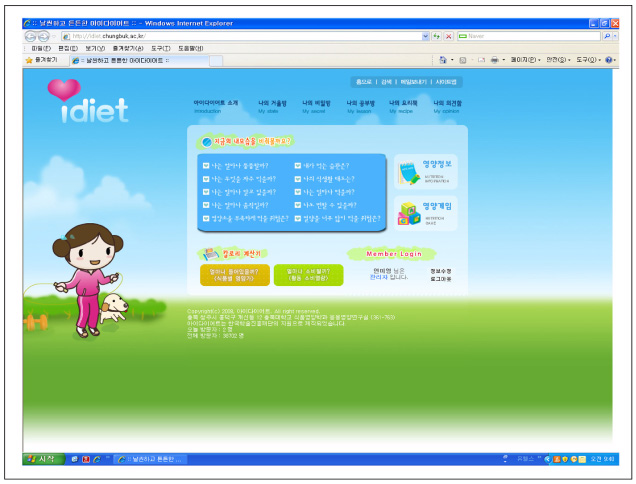
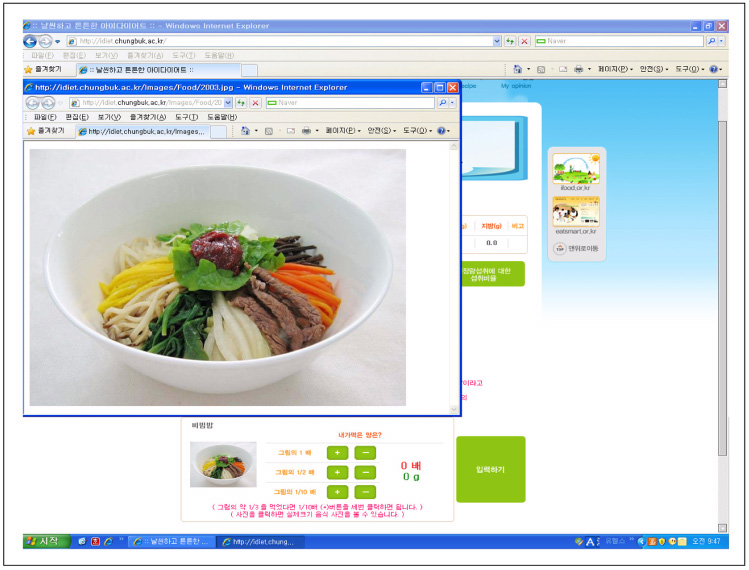

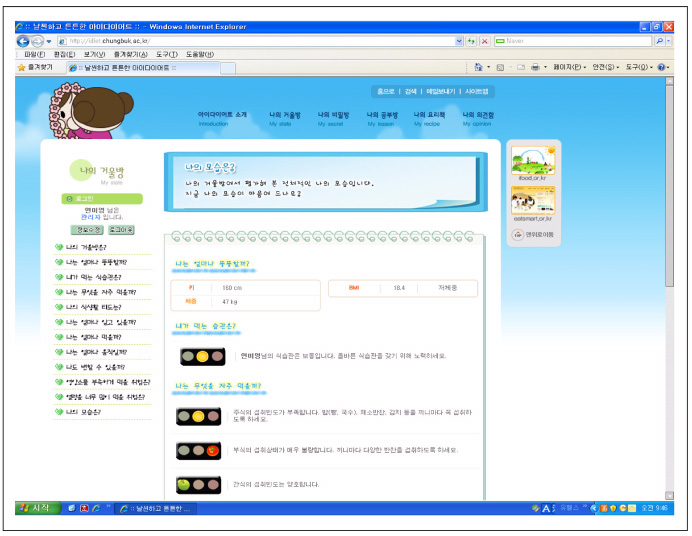
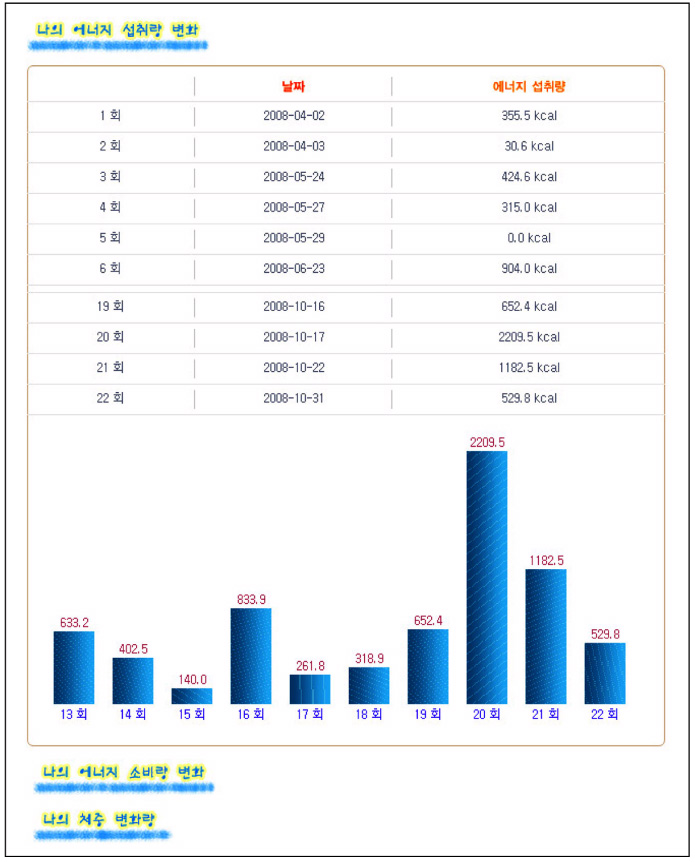
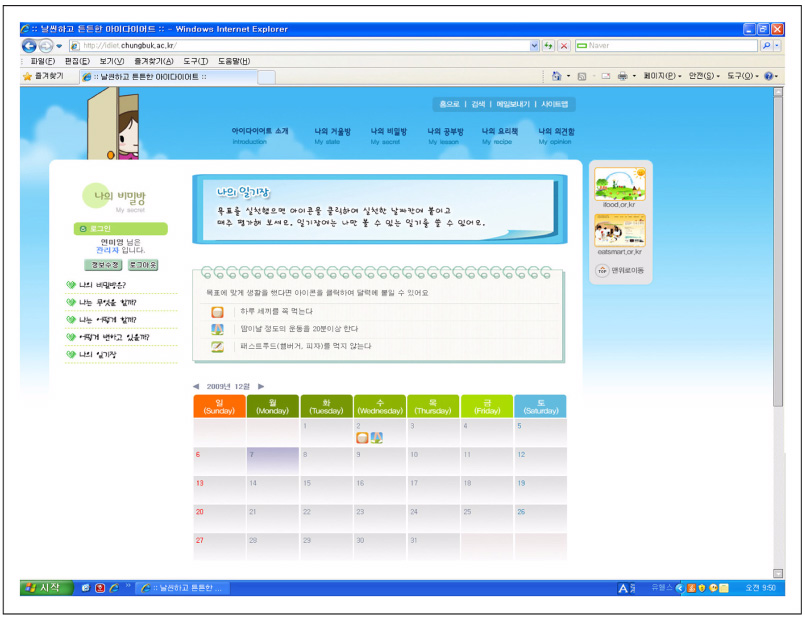
Fig. 1
Fig. 2
Fig. 3
Fig. 4
Fig. 5
Fig. 6
Sitemap of the website
Contents and programs developed in 'Assessment' part
1) Korea Centers for Disease Control and Prevention, Korean Pediatric Society (2007)
2) Korean Nutrition Society (2000)
3) Korean Nutrition Society (2005)
Contents and programs developed in 'Management' part
Contents and programs developed in 'Study' part
1) Korean Nutrition Society (2000)
Overall evaluation of the website
1) Mean ± SD (5=strongly agree, 4=agree, 3=neither agree nor disagree, 2=disagree, 1=strongly disagree)
2) N (%)
Evaluation of website contents
1) Mean ± SD (5 = strongly agree, 4 = agree, 3 = neither agree nor disagree, 2 = disagree, 1 = strongly disagree)
1) Korea Centers for Disease Control and Prevention, Korean Pediatric Society ( 2) Korean Nutrition Society ( 3) Korean Nutrition Society ( 4) Ainsworth et al (
1) Korean Nutrition Society ( 2) Ainsworth et al (
1) Mean ± SD (5=strongly agree, 4=agree, 3=neither agree nor disagree, 2=disagree, 1=strongly disagree) 2) N (%)
1) Mean ± SD (5 = strongly agree, 4 = agree, 3 = neither agree nor disagree, 2 = disagree, 1 = strongly disagree)

 KSCN
KSCN






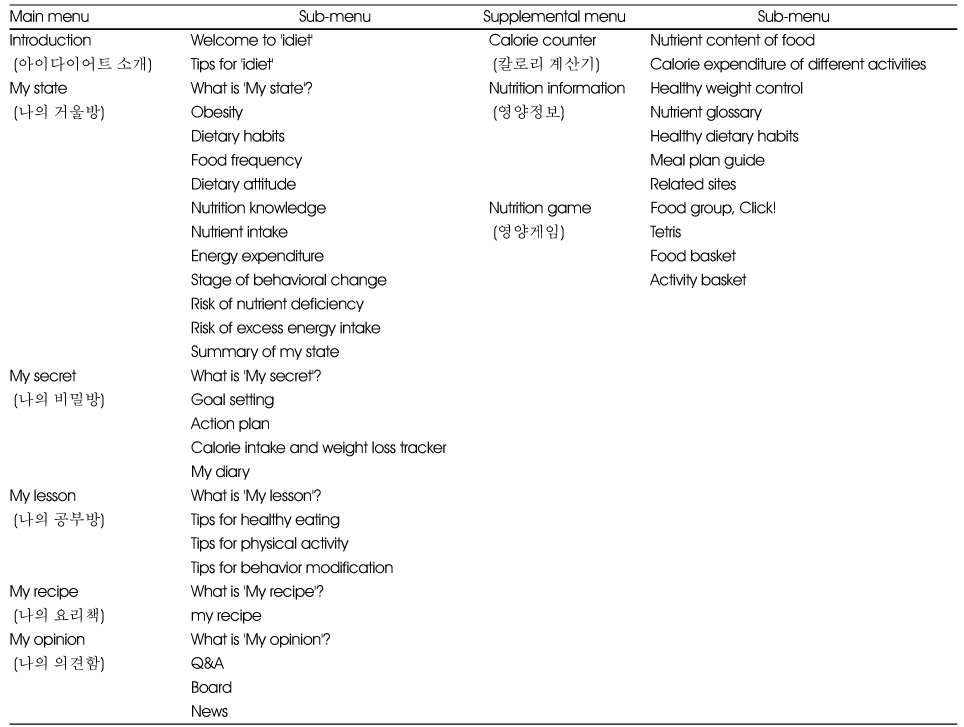

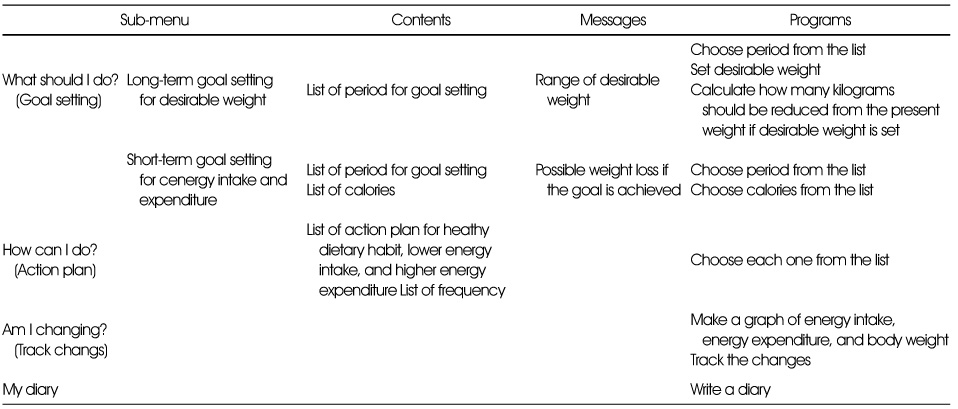
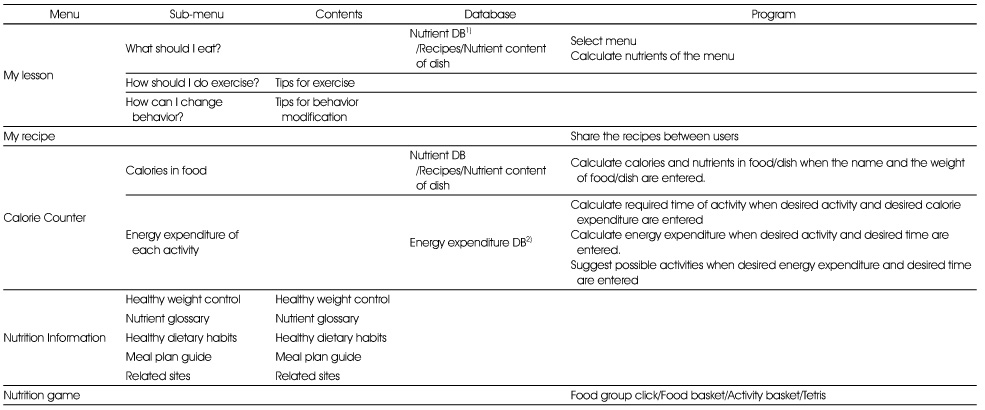


 PubReader
PubReader Cite
Cite


